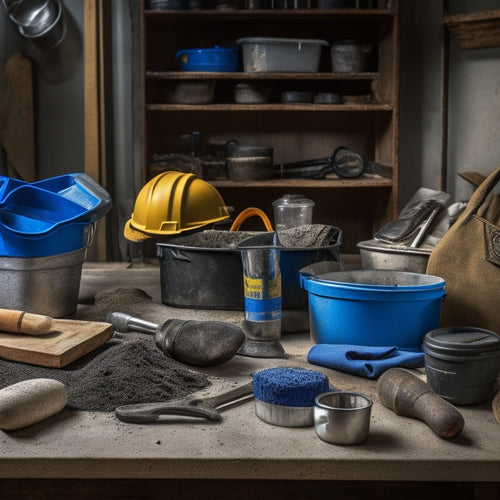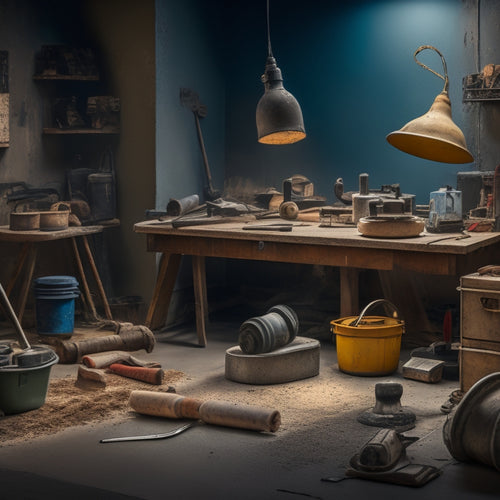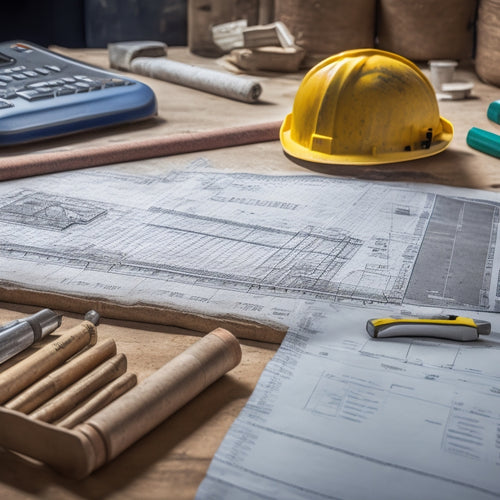
10 Best DIY Tools for Finishing Concrete Floors
Share
You'll need a strategic arsenal of tools to transform rough, uneven concrete floors into stunning, high-gloss surfaces. Edgers create smooth shifts between concrete and adjacent surfaces, while concrete grinders remove imperfections and rough spots. Floor scrapers take care of old coatings, and hand trowels provide finishing touches. Power floats guarantee flat surfaces, and concrete saws accurately cut joints. Floor polishers produce a high-gloss finish, brooms distribute coatings evenly, and knee boards keep you comfortable during prolonged kneeling. With these 10 essential DIY tools, you'll be well on your way to achieving a professional-looking finish - and the details that'll take your project to the next level await.
Key Takeaways
• Edgers create smooth transitions between concrete and adjacent surfaces, with metal edgers providing sharp edges and rubber edgers creating rounded profiles.
• Hand trowels are essential for smooth edge control and precise finish work, with specialized trowels providing high precision for edge finishing.
• Floor polishers, including rotary, oscillating, and planetary types, create a high-gloss finish when used with polishing compounds specifically designed for concrete.
• Concrete grinders, such as walk-behind, handheld, and edge grinders, remove imperfections and rough spots, and mastering grinding techniques results in a durable finish.
• Broom heads with different materials, such as natural bristle, nylon, polypropylene, and microfiber, are suitable for various coatings and provide smooth finishes.
Edgers for Smooth Transitions
When finishing concrete floors, you'll need edgers to create smooth changes between the concrete and adjacent surfaces, such as walls, cabinets, or plumbing fixtures. Edgers are essential for achieving a professional-looking finish, as they allow you to create seamless shifts between different surfaces.
To achieve this, you'll need to master various shift techniques, including using edging materials like metal, plastic, or rubber. Depending on the type of edger you choose, you can create different profiles, from a simple bevel to a more complex curved edge.
For example, a metal edger can be used to create a sharp, clean edge, while a rubber edger is better suited for creating a rounded profile. By selecting the right edging materials and mastering the proper shift techniques, you'll be able to create a smooth, cohesive look that enhances the overall aesthetic of your concrete floor.
With the right tools and techniques, you'll be able to achieve a finish that's both functional and visually appealing.
Concrete Grinders for Smoothening
As you move on to the next stage of finishing your concrete floor, you'll need a concrete grinder to smooth out the surface, removing any imperfections or rough spots that may have developed during the pouring or edging process. A concrete grinder is a powerful tool that uses rotating discs to grind and polish the concrete, leaving it smooth and even.
Here are some key considerations for choosing the right concrete grinder for your project:
| Grinder Type | Best For |
|---|---|
| Walk-behind grinder | Large areas, heavy grinding |
| Handheld grinder | Small areas, detail work |
| Planetary grinder | High-production grinding, polishing |
| Edge grinder | Grinding edges, corners, and tight spaces |
When using a concrete grinder, remember to follow important grinder safety tips, such as wearing protective gear, keeping the work area well-ventilated, and avoiding over-grinding, which can damage the concrete. By mastering concrete grinding techniques and using the right equipment, you'll be able to achieve a high-quality finish that will last for years to come.
Floor Scrapers for Old Coatings
You'll likely need a floor scraper to remove old coatings, adhesives, or mastics that can interfere with the bonding of your new finish.
When choosing a floor scraper, consider the type of coating you're dealing with, as different materials require specific removal techniques. For instance, epoxy coatings require a more aggressive scraper, while acrylic coatings need a gentler approach to avoid damaging the concrete beneath.
Coating compatibility is also essential; make certain the scraper you select is compatible with the old coating to prevent damaging the concrete or leaving residue that can affect the new finish.
Electric floor scrapers are ideal for large areas, while manual scrapers are better suited for smaller, more intricate spaces. Additionally, consider the scraper's blade material and angle, as these factors can impact the effectiveness of the removal process.
Hand Trowels for Finishing Touches
When you're finishing concrete floors, you'll need a hand trowel to achieve smooth edge control and precise finish work.
You'll use it to feather out edges, fill small imperfections, and create a uniform surface.
Smooth Edge Control
Achieve a razor-sharp edge by employing hand trowels specifically designed for finishing touches, which allow you to exert precise control over the final smoothing process.
These specialized tools are engineered to provide a high level of precision, enabling you to refine the edge finishing with utmost accuracy. By mastering control techniques, you can confidently tackle intricate areas, such as corners, curves, and shifts, where a smooth edge is vital.
When working on edge finishing, it's important to maintain consistent pressure and angle control. You'll want to use a gentle, sweeping motion to feather the concrete, blending it seamlessly with the surrounding surface.
As you work, pay attention to the trowel's edge, keeping it clean and free of excess material to prevent streaks and imperfections.
Precise Finish Work
With hand trowels specifically designed for finishing touches, you can execute precise finish work by manipulating the tool's angle and pressure to refine the concrete's surface texture and sheen. This is where your attention to detail and mastery of tool selection strategies come into play.
By choosing the right hand trowel for the job, you can achieve a high-gloss finish or a subtle texture, depending on your desired outcome.
Here are some key considerations for precise finish work with hand trowels:
-
Angle of attack: Experiment with different angles to achieve the desired texture and sheen.
-
Pressure control: Apply varying levels of pressure to manipulate the concrete's surface.
-
Trowel material: Select a trowel made from a material that complements the concrete's properties, such as stainless steel or high-carbon steel.
-
Finishing techniques comparison: Compare different finishing techniques, such as floating and troweling, to achieve the desired outcome.
-
Practice makes perfect: Refine your skills through repeated practice and experimentation to achieve a flawless finish.
Power Floats for Flat Surfaces
You'll typically use power floats on freshly poured concrete to produce a smooth, even surface, especially on large, flat areas like warehouse floors or parking garages. These machines are designed to remove imperfections and achieve a high-quality finish.
To get the best results, it's vital to master power float techniques, such as maintaining a consistent speed and applying the right amount of pressure. This will help you avoid marks, swirls, and other defects.
Regular power float maintenance is also important to guarantee peak performance and extend the lifespan of your equipment. This includes cleaning the float blades and checking for worn-out parts.
Additionally, make sure to lubricate the machine according to the manufacturer's instructions to prevent overheating and reduce wear on moving components. By following these guidelines, you'll be able to achieve a flawless finish on your concrete floors.
Tamping Tools for Compaction
When compacting freshly poured concrete, tamping tools are essential for eliminating air pockets and excess water that can weaken the slab's structural integrity.
You'll want to use the right tamping techniques to guarantee a strong, durable finish. By compacting the concrete, you'll achieve better compaction benefits, such as increased strength, reduced shrinkage, and improved durability.
Here are some key tamping tools you'll need:
-
Hand tamper: ideal for small areas and tight spaces
-
Plate compactor: perfect for larger areas, it provides maximum compaction force
-
Tamping rod: helps to compact and level the concrete
-
Bull float: a long-handled tool used to tamp and smooth out the surface
-
Vibrating screed: a high-tech tool that uses vibrations to compact and level the concrete
Concrete Saws for Cutting Joints
When you're working with concrete saws to cut joints, it's essential that you accurately control the cutting depth to achieve the desired joint pattern.
You'll need to determine the ideal joint depth based on the concrete's thickness and the desired crack pattern, ensuring that the saw blade doesn't cut too deeply and compromise the slab's structural integrity.
Cutting Joint Depth
By the time you're ready to cut joints, you've likely already prepared your concrete floor for finishing. Now, it's vital to accurately determine the cutting joint depth to guarantee a professional-looking result.
The key to achieving this lies in understanding the importance of joint spacing and cutting techniques.
When it comes to cutting joint depth, you'll need to take into account the following essential factors:
-
Joint spacing: Make certain joints are spaced correctly to prevent cracking and allow for expansion.
-
Concrete thickness: The depth of your concrete floor will influence the joint depth required.
-
Moisture levels: High moisture levels may require deeper joints to accommodate shrinkage.
-
Load-bearing capacity: Reflect on the weight and stress your floor will be subjected to when determining joint depth.
-
Aesthetics: Don't forget to factor in the visual appeal you want to achieve with your finished floor.
Precise Cutting Techniques
To achieve precise cutting techniques for concrete joints, you'll need to master the art of operating a concrete saw, a powerful tool capable of making accurate cuts in your freshly poured concrete floor. With the right technique and equipment, you can guarantee cutting accuracy and achieve professional-looking results.
When it comes to blade selection, you'll want to choose a blade specifically designed for concrete cutting. These blades typically feature diamond-coated edges that effectively cut through concrete without compromising the surrounding material. For best results, select a blade with a high diamond concentration and a narrow kerf (the width of the cut).
As you operate the concrete saw, maintain a steady pace and apply consistent pressure. This will help you achieve a smooth, even cut and prevent the saw from bogging down. Additionally, keep the saw blade clean and well-lubricated to prevent overheating and guarantee peak performance.
Floor Polishers for High Shine
You'll achieve a high-gloss finish with floor polishers specifically designed for concrete, which employ advanced technologies to refine the surface and produce a mirror-like sheen.
When selecting a polisher, consider the type of concrete you're working with, as well as the level of shine you desire. There are various polisher types, including rotary, oscillating, and planetary, each suited for specific polishing techniques.
To get the best results, choose a polisher that fits your needs and follow these tips:
-
Start with a low-grit pad and progress to higher grits for a high-shine finish.
-
Use a polishing compound specifically designed for concrete to enhance the shine.
-
Work in small sections to maintain even coverage and avoid swirl marks.
-
Apply moderate pressure, increasing as needed for more aggressive polishing.
-
Regularly clean the polisher and pads to prevent scratching the concrete surface.
Brooms for Even Coating Distribution
When selecting a broom for even coating distribution on your concrete floor, you'll want to take into account a few key factors.
You'll need to think about the material of the broom head, as well as the length and ergonomics of the handle, to guarantee comfortable and efficient use.
Broom Head Material Matters
What sets a broom apart from just being a simple sweeping tool is the material of its head, which greatly impacts the even distribution of coatings on your concrete floor. When it comes to broom head durability, you want a material that can withstand the demands of your project. The right broom head material guarantees a smooth, consistent finish and prevents uneven coating distribution.
Here are some common broom head types to take into account:
-
Natural Bristle: Ideal for applying epoxy and other thick coatings, natural bristle brooms provide excellent texture and hold a lot of material.
-
Nylon Bristle: Suitable for water-based coatings and sealers, nylon bristle brooms are resistant to water and cleaning solvents.
-
Polypropylene Bristle: These brooms are perfect for applying thin coatings and provide a smooth finish.
-
Microfiber: Microfiber brooms are great for applying ultra-thin coatings and provide an extremely smooth finish.
-
Blended Bristle: A combination of natural and synthetic fibers, blended bristle brooms offer a balance of durability and smooth finish.
Handle Length and Ergonomics
With a broom in hand, set the stage for even coating distribution by selecting a handle length that fits your stride and ergonomic needs, ensuring a comfortable, fatigue-free application process.
As you evaluate handles, consider the materials used, such as durable fiberglass, lightweight aluminum, or sturdy wood. Each material has its advantages, so choose one that suits your specific requirements.
Next, think about adjustable lengths. This feature allows you to customize the handle to your ideal working height, reducing strain on your back and shoulders. Look for brooms with telescoping or locking mechanisms that enable effortless adjustments. This adaptability is particularly useful when working on large or complex concrete floors.
When selecting a handle, also consider the grip material and design. A contoured grip with a non-slip coating can help reduce fatigue and improve control. Additionally, some handles feature built-in hooks or holders for convenient storage and organization.
Brush Angle and Flexibility
Optimize your broom's brush angle to guarantee even coating distribution by selecting a model that offers adjustable or flexible heads. This allows you to effortlessly adapt to varying floor surfaces and contours. This feature is essential for achieving a uniform finish, especially when working with complex floor geometries.
When choosing a broom, consider the following factors to ascertain the ideal brush angle and flexibility:
-
Adjustable head: Allows for easy adaptation to different floor angles and surfaces.
-
Flexible bristles: Enables smooth, even coating distribution on irregular surfaces.
-
Durable brush construction: Withstands heavy use and maintains its shape, securing consistent results.
-
Ergonomic design: Reduces fatigue and improves control, enabling precise application techniques.
-
Customizable brush angles: Accommodates various application techniques, from broad strokes to precision edges.
Knee Boards for Comfortable Working
You'll appreciate the comfort and support knee boards provide when working on concrete floors, particularly during prolonged periods of kneeling. These innovative tools are designed to reduce fatigue and discomfort, allowing you to focus on the task at hand.
One of the primary knee board benefits is their ergonomic designs, which cradle your knees and provide superior support. This means you can work for extended periods without feeling the strain on your joints.
When choosing a knee board, look for models with thick, durable padding and a sturdy frame that can withstand the demands of concrete finishing. Adjustable straps and Velcro closures guarantee a secure fit, while textured surfaces provide traction to prevent slipping.
Frequently Asked Questions
What Safety Gear Is Essential When Working With Concrete Finishing Tools?
When working with concrete finishing tools, you'll need essential safety gear like safety goggles to protect your eyes from debris and dust masks to prevent inhaling harmful particles, ensuring a safe and healthy work environment.
Can I Finish a Concrete Floor Without Using a Floor Scraper First?
"Rewind to the medieval era, where castle floors were polished to perfection; now, back to your concrete floor preparation. You can skip the floor scraper, but be prepared for subpar finishing techniques and potential rework."
How Often Should I Maintain and Clean My DIY Concrete Finishing Tools?
You should maintain your DIY concrete finishing tools regularly, cleaning them after each use and performing in-depth cleaning every 1-2 weeks to prevent damage and guarantee peak performance, extending tool lifespan.
Are There Any Eco-Friendly Alternatives to Traditional Concrete Finishing Products?
When exploring eco-friendly alternatives, you'll find innovative options like eco-friendly sealers and sustainable additives that reduce environmental impact, allowing you to create a greener, more responsible concrete finish that meets your high standards.
Can I Use Concrete Finishing Tools on Freshly Poured Concrete Floors?
"Rome wasn't built in a day" - and neither should you rush into finishing a freshly poured concrete floor. You'll need to wait until it's set enough to support your weight and allow for proper concrete finishing techniques, like using the best trowel types for a smooth finish.
Conclusion
As you stand back to admire your newly finished concrete floor, it's hard not to feel a sense of pride and accomplishment.
Coincidentally, that's exactly what you'll get with the right DIY tools for the job. From edgers to floor polishers, each tool played a vital role in achieving that flawless finish.
You've saved time and money, and gained a sense of satisfaction that comes with doing it yourself. Your hard work has paid off, and your floor is now a reflection of your DIY prowess.
Related Posts
-

5 Tools Needed for Quick Fix Concrete Mixing
You'll need five essential tools to tackle a quick fix concrete mixing project efficiently. First, you'll require a s...
-

Top Concrete Resurfacing Tools for a Pro Finish
When it comes to achieving a professional finish in concrete resurfacing projects, you require the right set of speci...
-

5 Tips for Accurate Concrete Measurement Tools
To guarantee accurate concrete measurement, you'll want to calibrate your measuring tools regularly, choosing a frequ...


